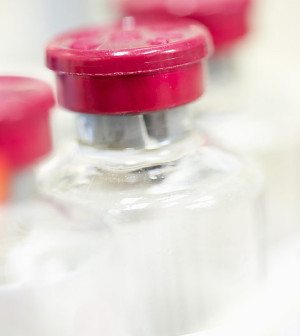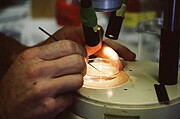- Navigating Your Midlife Crisis: Embracing New Possibilities
- City Raccoons Showing Signs of Domestication
- Mapping the Exposome: Science Broadens Focus to Environmental Disease Triggers
- One Week Less on Social Media Linked to Better Mental Health
- Your Brain Changes in Stages as You Age, Study Finds
- Some Suicide Victims Show No Typical Warning Signs, Study Finds
- ByHeart Formula Faces Lawsuits After Babies Sickened With Botulism
- Switch to Vegan Diet Could Cut Your Greenhouse Gas Emissions in Half
- Regular Bedtime Does Wonders for Blood Pressure
- Dining Alone Could Mean Worse Nutrition for Seniors
Scientists Explore How Fecal Transplant Eases Tough Infection


Patients suffering from the nasty bacterial infection known as Clostridium difficile often must choose between standard antibiotics and a procedure known as fecal transplantation to deal with the digestive tract disorder.
The fecal transplant involves harvesting good bacteria from the stool of a healthy donor and inserting it into the intestines of a sick patient.
The process often succeeds where antibiotics fail — by restoring healthy bacteria and functioning to the recipient’s gut, new research suggests. But the procedure is poorly understood and invasive.
Researchers want to fashion a new treatment with all the upside and none of the downside for treating recurrent C. difficile, one of the most common infections acquired in American health care settings.
“Basically what we’re trying to do is figure out why fecal transplantation works,” said Dr. Vincent Young, an associate professor in the division of infectious diseases at the University of Michigan in Ann Arbor.
“We know we have to replace the patient’s bacteria. But we don’t know what role they play once we do,” Young added.
“It could be that the bacteria we use needs to be living. Or it could be that the bacteria produce something that we can isolate, and then deliver directly to patients without living bacteria and, therefore, without fecal matter. That’s the hope,” he said.
Young and his team published their findings in the May/June online edition of mBio.
The U.S. Centers for Disease Control and Prevention estimates that about 14,000 Americans die of C. difficile each year. Most at risk are older people who take antibiotics and also get medical care, the CDC noted. It’s believed antibiotics disrupt the balance of bacteria in the gut, increasing susceptibility to infection.
Antibiotics are one option for treating the severe diarrhea, vomiting and abdominal discomfort that can follow infection.
However, roughly 40 percent of treated patients experience disease recurrence. What’s more, antibiotics sweep out good bacteria along with the bad.
As an alternative, fecal transplantation essentially places an army of good bacteria into besieged territory, where it “smart-bombs” only the bad C. difficile bacteria that might otherwise elude antibiotics.
How it does that remains unclear. But the process, which reportedly dates back to 4th-century China, has been available to American patients since the 1950s. By some estimates, the success rate exceeds 90 percent.
The problem: Fecal transplants are delivered either by colonoscopy, by a tube threaded through the stomach, or by enema — all somewhat unpalatable therapies.
Although Canadian researchers last fall reported success with a pill form of fecal delivery, that method is not yet approved by the U.S. Food and Drug Administration for general use.
For Young’s study, the researchers conducted a comparative DNA analysis of bacteria found in stool samples from 14 C. difficile patients at a clinic in Minnesota.
All had experienced recurrent infections, and all had completed an ineffective regimen of antibiotics.
The samples were collected before undergoing fecal transplantation, and again two to four weeks following treatment, the study authors noted.
In addition, stool samples taken from 10 of the patients were compared with samples taken from healthy donors.
The team found a wide range of bacterial environments across samples, with the closest similarities seen among those taken from healthy donors and treated patients.
Compared with untreated patients, treated patients had a reduced population of problematic “proteobacteria” and an increase of beneficial “firmicutes and bacteroidetes” bacteria, the investigators found.
The researchers also isolated 75 different pathways by which the bacterial environment post-transplantation waged a war of resistance against C. difficile.
“So clearly there’s not one thing that stuck out,” said Young. “And we don’t yet know which of these pathways are important.”
Although new insights have been gained, “we’re going to have to drill down even further going forward,” Young added.
Another expert welcomed the new findings.
This work is “very exciting,” said Jeffrey Cirillo, a professor of microbial and molecular pathogenesis at the Texas A&M Health Science Center College of Medicine in Bryan, Texas.
“It is interesting that not only do the recipients recover more quickly from [fecal material] treatment, but they also have a more diverse population of bacteria present,” Cirillo said.
These observations hold promise for development of new methods to prevent recurrent infections, Cirillo added.
More information
For more about fecal transplantation, visit the Fecal Transplant Foundation.
Source: HealthDay
Copyright © 2025 HealthDay. All rights reserved.










